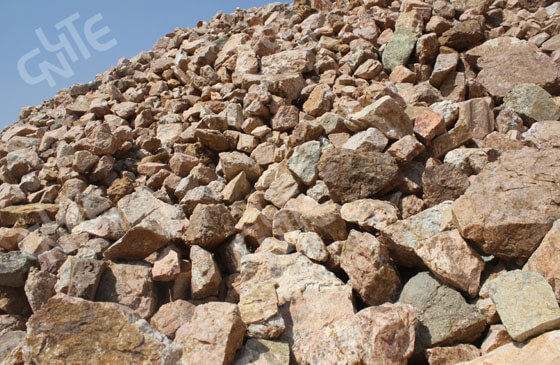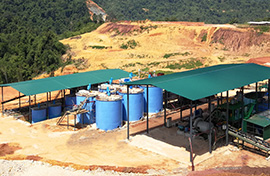-
 E-mail
shirleyyin321@gmail.com
E-mail
shirleyyin321@gmail.com
-
 Call Us
0086 18716000713
Call Us
0086 18716000713
 E-mail
shirleyyin321@gmail.com
E-mail
shirleyyin321@gmail.com
 Call Us
0086 18716000713
Call Us
0086 18716000713
2020-01-10 Views: 2511
Warm Tip: If you want to know more information, like quotation, products, solutions, etc., please Click here ,and contact us online.

The choice of gold extraction process is closely related to the type of gold ore. Because the type of gold ore, determines the applicable process of gold mine to a large extent. This article introduces different types of gold ores and their applicable extraction processes.
First, according to the relationship between gold and the main gold-bearing minerals in the ore and the minerals that affect the extraction process, the gold ore can be divided into the following 12 types.
Alluvial gold ore refers to the ore formed by the primary gold deposit that has been deposited by weathering, separation and transportation after various geological effects. Its main component is quartz, and the particle size is generally less than 50-100 microns. The structure is loose, and it does not need to be crushed and ground. So alluvial gold extraction is easier. Gravity separation process and amalgamation process are more fitful for alluvial gold extraction. This process can recovery 95% gold.
Main gold extraction processes: gravity separation, addition of mercury and impurities removing, dehydration and distillation, smelting.
The ancient placer gold ore is the petrified placer ore, which is composed of the petrolized gravel. The particle size of 80% ore is between 75-100 microns. And this type of ore has a high grade. Gravity separation and cyanidation is a better process for gold extraction. Because it can recover more than 95% gold.
Main gold extraction processes: gravity separation, tailings leaching, deposition extraction, smelting.
Quartz is the main component of gold-bearing quartz vein ore, but the only recyclable useful component is gold. Gold exists in the form of granules and has a coarse particle size. The gold particles can be exposed by grinding. Generally, this type of gold ore can be effectively extracted through the combination of gravity separation with mercury and cyanidation gold extraction. The gold extraction process is simple and the gold recovery rate is high.
However, there is also a quartz vein gold ore with extremely small gold-containing particles that are immersed in the quartz veins. At present, this type of gold cannot be extracted by the existing technology.
Gold ore exists in the dissociation state of alteration products of pyrite or other sulfides, especially iron oxides. The structure of the oxidized gold ore is destroyed, the water permeability is greatly enhanced, so we can achieve high recovery by heap leaching with raw ore. Generally, gold extraction by cyanidation can recover higher grade concentrate. However, sometimes due to oxidation, the surface of gold is often covered with a secondary water-containing oxide film, which will affect the effect of cyanidation. At this time, the ore can be extracted by gravity separation.
Silver-rich gold ore is a symbiosis of gold and silver. The composition of silver-gold ore or gold-silver ore can recover a considerable amount of silver. Generally, this type of gold ore is closely related to pyrite, so we use flotation for this type of gold extraction, which can enrich silver ore at same time, then use cyanidation to extract gold and silver.
Main gold extraction processes: grinding, flotation enrichment of concentrates, leaching of flotation tailings, sediment extraction, smelting
The iron-bearing sulfide gold ore belongs to quartz vein type ore, the main component is quartz, but it contains a certain amount of iron sulfide mineral. And gold exists in different forms in this type of ore. When the ore contains a small amount of sulfide and is mainly present in the form of pyrite, the particle size of the gold is coarse. We can use a simple gold extraction process for this type of ore.
When the ore contains more sulfides, and the pyrite and gold ore are co-exist, pyrite can be extracted as a by-product. This type of gold may has different states. When the gold particle is coarse, simple grinding can extract the gold; when the gold particle is fine and being wrapped by pyrite, it would be more difficult to extract. The cyanidation method consumes a lot of chemicals and oxygen, but it still cannot extract gold fully.
Gold arsenic sulfide gold ore refers to the gold ore associated with arsenic sulfide, mostly are pyrite and arsenic pyrite, because arsenic pyrite is the second gold pyrite-containing sulfide mineral in gold ore. Due to the low grade of gold, we should use flotation to enrich sulfide mineral and gold ore, then extract gold.
Copper-bearing sulfide gold ore refers to some form of copper ore and gold symbiosis in the gold ore, and coexists with pyrite. For copper-bearing sulfide gold extraction, we can enrich gold in copper concentrate by flotation, and then comprehensively recover copper and gold by smelting. For gold-bearing pyrite, we use cyanidation gold extraction process.
Antimony-bearing sulfide gold ore refers to the antimony-bearing sulfide or gold ore in which antimony minerals exist independently. This type of ore is generally difficult to be extracted by amalgamation and cyanidation directly, so flotation, roasting, and cyanidation gold extraction processes are often used to extract this type of gold.
Telluride gold ores generally refer to ores containing natural gold and sulfide minerals, which have high economic value. Gold extraction from this type of ore can be different, because whether this ore contains silver or not, it dissolves very slowly in cyanide solutions, so a pre-oxidation stage is usually added before cyanidation.
Polymetallic sulfide gold ores containing lead, zinc, and copper refer to ores that coexist with gold ores and considerable amounts of copper, lead, zinc, and other sulfur ores. The secondary ore has many components that can be extracted. Gold is present in different particles, which is unevenly distributed. Flotation gold extraction process is mostly used for polymetallic ore. Generally, gold is enriched in non-ferrous metal ores and then comprehensively extracted through smelting. But for gold-bearing pyrite, it needs to be recovered by cyanidation after flotation extraction process.
Carbonaceous gold ore is a type of gold ore that contains symbiotic carbon such as activated carbon, hydrocarbons, graphite, and some forms of pyrite. Most gold extraction from this type of ore is achieved by cyanidation. But sometimes this type of ore also contains a certain amount of clay which can preemptively adsorb gold-cyanide complexes during the cyanidation process with carbon, and affects the efficiency of cyanidation. So it needs to perform oxidative pretreatment.
In short, different gold extraction processes will bring different economic benefits. Therefore, if you want to extract gold to obtain high-grade gold concentrates, you must first understand what type of gold you own, and then find the corresponding process, so that you can efficiently recover gold.
No. 188, Xinhai Street, high-tech Industrial Park, Fushan District, Yantai, Shandong, China.

Please leave your message here! We will send detail technical info and quotation to you!